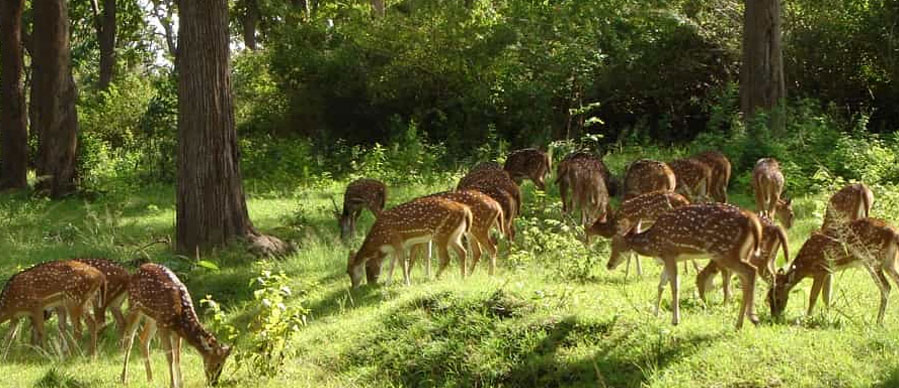Exploring the Wildlife Heritage of Bandipur: A Journey into Nature's Splendor

Bandipur National Park, located in the southern Indian state of Karnataka, is a haven for wildlife enthusiasts and nature lovers. Established in 1974 as a tiger reserve under Project Tiger, Bandipur is part of the Nilgiri Biosphere Reserve and shares its boundaries with the states of Tamil Nadu and Kerala. This sprawling 874-square-kilometer park is renowned for its diverse flora and fauna, making it one of India’s premier wildlife destinations. In this blog, we delve into the rich wildlife heritage of Bandipur and what makes it a must-visit for anyone passionate about the natural world.
The Majesty of Bandipur's Fauna
Bandipur National Park is home to a stunning variety of wildlife. The park’s dense forests and open grasslands provide the perfect habitat for a wide range of species. Among the most iconic residents of Bandipur are the Bengal tigers. The park’s tiger population is a major draw for tourists, offering a rare chance to see these magnificent predators in their natural habitat. Spotting a tiger in the wild is a thrilling experience, one that leaves visitors in awe of these majestic creatures.
In addition to tigers, Bandipur boasts a healthy population of Indian elephants. These gentle giants are often seen in herds, traversing the park’s terrain in search of food and water. Observing elephants in the wild, with their complex social structures and behaviors, is a highlight for many visitors.
Leopards, though elusive, also roam the park. Their spotted coats provide excellent camouflage in the dense underbrush, making sightings a special event. Other significant mammals in Bandipur include the Indian bison (gaur), sambar deer, chital (spotted deer), and the endangered Indian wild dog (dhole). The park's diverse ecosystem supports over 200 species of birds, making it a paradise for bird watchers. From the majestic crested serpent eagle to the colorful Indian roller, the avian diversity here is remarkable.
Flora: The Lush Green Canopy
The vegetation in Bandipur is equally diverse, ranging from dry deciduous forests to moist deciduous and shrublands. The park is dotted with valuable timber trees such as teak, rosewood, and sandalwood. These forests not only provide shelter and food for the wildlife but also play a crucial role in maintaining the ecological balance of the region.
Bandipur’s flora includes an array of medicinal plants and herbs, used traditionally by local communities for their healing properties. The seasonal changes bring a variety of blooms, adding splashes of color to the verdant landscape and creating a vibrant ecosystem teeming with life.
Conservation Efforts and Challenges
Bandipur’s designation as a national park and tiger reserve underscores its importance in conservation efforts. The park is a critical refuge for many endangered and threatened species. Conservation initiatives in Bandipur focus on habitat restoration, anti-poaching measures, and community involvement. Forest department officials and various NGOs work tirelessly to protect the park’s biodiversity.
Despite these efforts, Bandipur faces several challenges. Human-wildlife conflict, particularly with elephants straying into agricultural areas, poses significant issues. Habitat fragmentation and the pressure of tourism also threaten the delicate balance of this ecosystem. Sustainable tourism practices are essential to ensure that visitors can enjoy Bandipur’s natural beauty without causing harm.
Exploring Bandipur: Tips for Visitors
For those planning a visit to Bandipur, there are several ways to explore the park. Jeep safaris are the most popular, offering a chance to venture deep into the wilderness and witness the wildlife up close. Accompanied by knowledgeable guides, these safaris provide educational insights into the park’s ecology and the behaviors of its inhabitants.
Visitors should also consider guided nature walks and bird-watching tours. These activities allow for a more intimate experience with Bandipur’s flora and fauna, revealing the smaller, often overlooked aspects of the ecosystem. The best times to visit are during the dry months from October to May when wildlife sightings are more frequent as animals gather around water sources.
Accommodation options near Bandipur range from luxury resorts to eco-friendly lodges and budget hotels, catering to all types of travelers. Staying in these accommodations often enhances the experience, as many offer additional activities like nature trails, night safaris, and educational programs about conservation efforts.
Conclusion
Bandipur National Park stands as a testament to India’s rich wildlife heritage. Its lush landscapes, diverse species, and ongoing conservation efforts make it a vital sanctuary for nature. For anyone seeking to connect with the wild and witness the wonders of the natural world, Bandipur offers an unparalleled experience. By visiting and supporting such protected areas, we contribute to the preservation of these irreplaceable treasures for future generations to cherish and enjoy.





